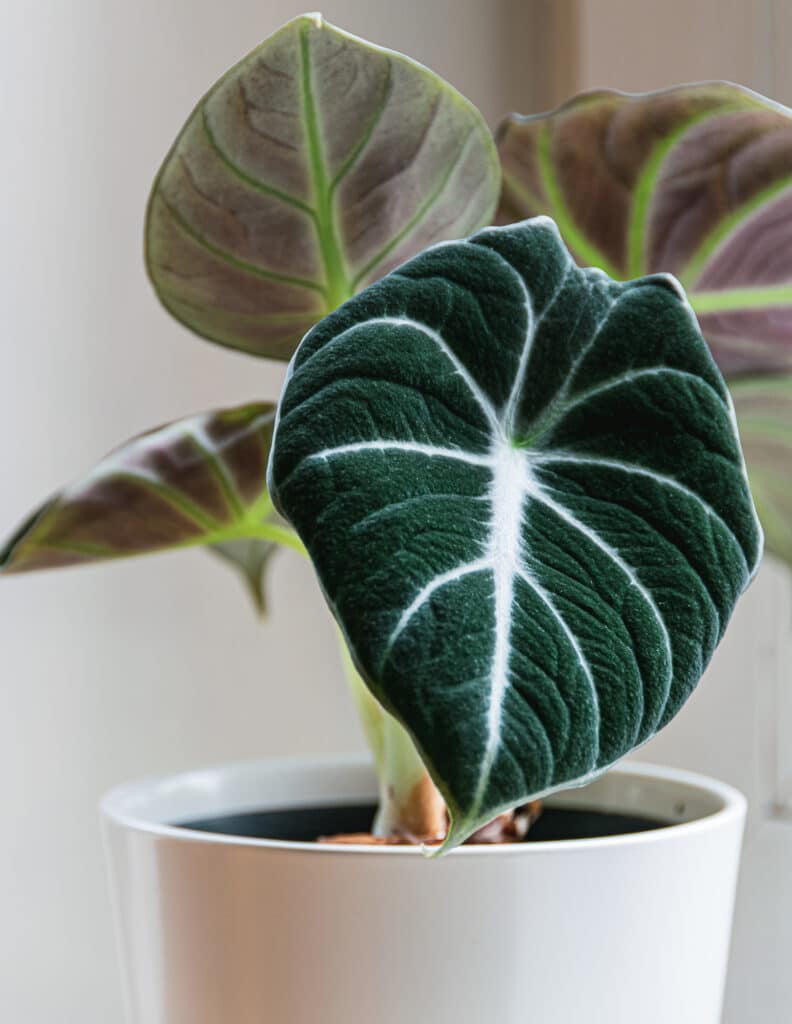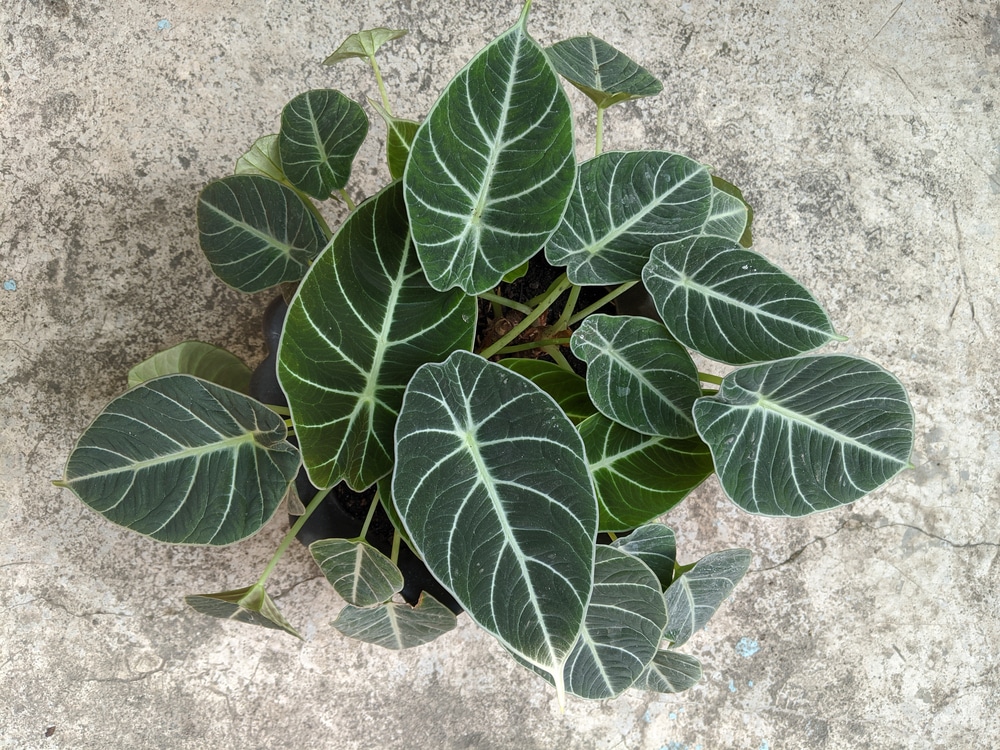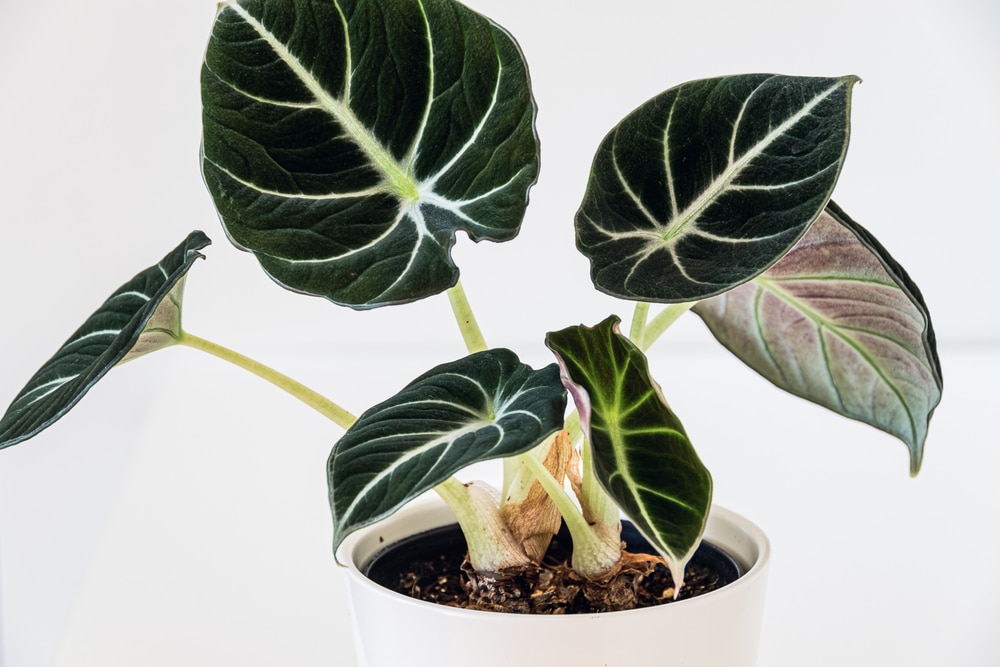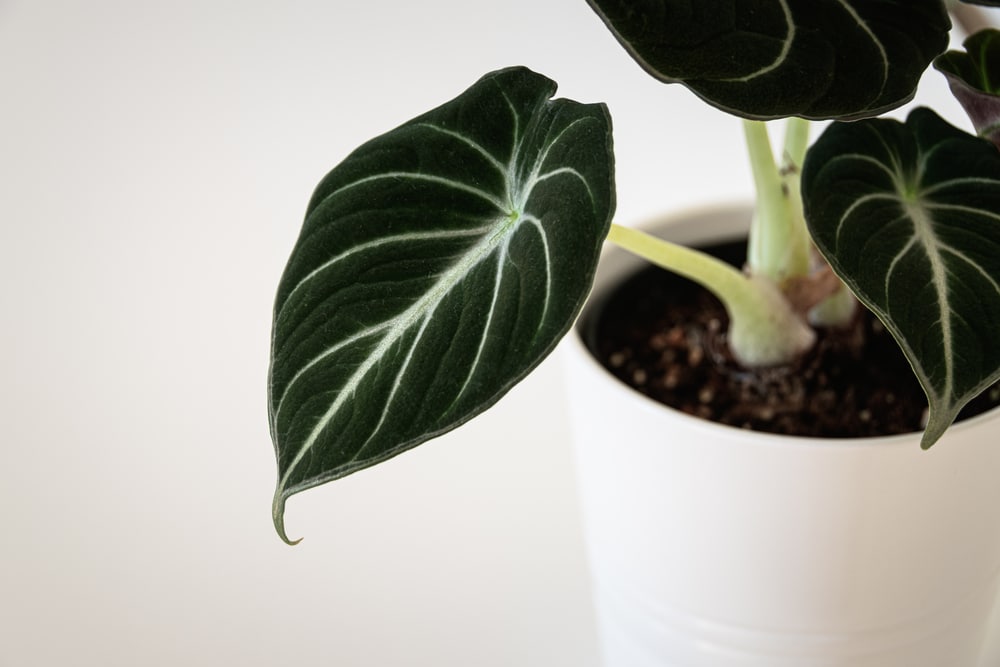Despite her dramatic appearance, dark green leaves, and regal title, Alocasia Black Velvet (Alocasia reginula) is an easily manageable (if a little particular), addition to any tropical plant display. Her small stature is perfect for even the most compact of spaces and her deep, inky foliage is sure to stand out proudly amongst a spectrum of conventional greenery.
In this article we will cover everything you need to know about keeping Alocasia Black Velvet in your home.
At a Glance – Alocasia Black Velvet Care
| Common Name | Alocasia Black Velvet, Black Velvet Alocasia |
| Botanical Name | Alocasia reginula ‘Alocasia Black Velvet’ |
| Native Areas | Tropical and subtropical regions of Asia |
| Light Requirements | Bright, indirect light (low light tolerant) |
| Watering | Favor very light but regular waterings |
| Soil | Coarse and loose soil which drains freely |
| Temperature | 55°F to 86°F |
| Humidity | 50% to 75% |
| Hardiness Zones | USDA Zones 10 to 12 |
Origin and History
Alocasia reginula ‘Alocasia Black Velvet’ is one of 97 accepted species within the alocasia genera, belonging to the Araceae family.
Native to tropical and subtropical regions of Asia, this evergreen, rhizomatous perennial was first collected from the rainforests of Borneo during the 1860s by British botanists, when it soon gained popularity amongst early houseplant enthusiasts.
Its botanical name reginula means ‘little queen’, a suitable homage to its small yet splendid appearance.
Appearance

Alocasia Black Velvet is a miniature or ‘jewel’ alocasia variety, remaining neat and compact even at peak maturity.
Its leaves, as the name might suggest, are often such a dark green that they appear black, and have a soft, fuzzy, velvety texture. Criss-crossing each leaf in an orderly fashion are striking porcelain-pale veins, starkly contrasting with the swarthy foliage.
Its leaves are thick, almost succulent-like, and are vaguely heart or teardrop-shaped, reaching around six inches long and just over two inches in width.
The dark green color of the leaves developed as a means of absorbing as much light as possible from their native habitats on the shaded forest floors, whilst the pale veins reflect light towards the leaves.
Alocasia Black Velvet Care
In this section we cover important Alocasia reginula ‘Alocasia Black Velvet’ care topics such as watering, lighting, fertilizing, potting, and more.
Growth Habit
Alocasia Black Velvet has a compact growth habit, seldom reaching more than 20 inches tall, with a spread of around ten inches.
Like other alocasias, older leaves will die off periodically to make way for new growth. Any new growth sprouts from the center of the plant. Although Alocasia Black Velvet is relatively slow-growing, it will grow noticeably faster during the warmer months.
Light
Because it is used to the sparse, dappled light conditions of the rainforest floor, Alocasia Black Velvet can withstand relatively low light conditions in the home but thrives best when exposed to bright, indirect light.
North or east-facing windows are prime positions for black velvet as they won’t tolerate direct light. Overexposure to sunlight can cause the deep color of the foliage to lighten or the leaves to curl and become scorched.
Displaying your Alocasia Black Velvet in amongst other plants will help to mimic the dappled light of the rainforest floor.
Because of its velvety texture, dust settles easily on the leaves, which can prevent your black velvet from photosynthesizing effectively. Regularly wiping the leaves over will remove any dust and ensure your plant receives enough energy.

Water
Alocasia Black Velvet is quite particular when it comes to watering. Prone to root rot, they can’t tolerate consistently wet soil but they don’t appreciate overly dry conditions either.
The thick leaves of black velvet are excellent at retaining water, so they favor very light but regular waterings, as opposed to more sporadic soakings. Allow the top one to two inches of soil to dry completely between waterings. Make sure you allow both the soil and the pot to drain fully after each watering and do not leave the pot to rest in standing water in drip trays or saucers.
The watering frequency can be increased slightly during the warmer months, but be mindful not to let the soil become oversaturated. In cool weather or periods of dormancy, you can reduce watering considerably.
Alocasia Black Velvet is quite sensitive, so avoid chlorinated water. If your tap water is heavily chlorinated, you can leave the water to stand out for 24 hours before watering.
Temperature and Humidity
Alocasia Black Velvet likes a warm and humid environment that mimics the rainforest habitat. You should aim for an ambient temperature of between 55-86°F.
Alocasia plants are not cold-hardy, so keep them away from draughty positions or air conditioning units. In the winter, you may need to move your black velvet away from windows where the temperature will be cooler.
The warmer your environment, the faster your black velvet will grow. Try not to let the temperature drop below 55°F as your black velvet could become dormant.
Achieving the correct balance between humidity and water can be tricky, since black velvet loves humidity, but hates moist soil. Consistent humidity is crucial for healthy growth and a moderate to high humidity level of between 50-75% should keep your plant happy, but it may struggle if humidity levels drop below 50%. If you can get the humidity levels right then this reduces the need for regular watering.
A pebble tray is an an excellent way to maintain consistent moisture levels, or you could group your Alocasia Black Velvet with other humidity-loving plants to create a moisture-rich microclimate with your plant display.
Kitchens and bathrooms tend to offer the kind of consistent humidity levels that black velvet loves. Misting is generally not advisable due to the fuzzy foliage retaining moisture which can cause fungal infections.
Soil and Pots
Your Alocasia Black Velvet will need coarse and loose soil which drains freely after watering and doesn’t soak up too much excess moisture. Since the roots of black velvet like to breathe, a substrate mix with a high perlite or vermiculite content is essential for maintaining aerated soil. Adding sand or orchid bark will also help with drainage.
Avoid adding too many moisture retentive materials like coco coir or sphagnum moss as these will hold too much water. Your black velvet will appreciate slightly acidic soil with a pH of around 5.5 to 6.5.
Choosing a pot with drainage holes is essential to prevent the soil from becoming waterlogged and root-rot taking hold.
Alocasia Black Velvet will flourish when they are allowed to come slightly root-bound, so a snug-fitting pot is best. Pots that are too large for the compact root system will need extra soil which will retain unnecessary moisture.
Fertilizing
Alocasia black velvet has a relatively low appetite so dilute any general-purpose fertilizer, or reduce the amount by half the recommended dose.
During the warmer growing season, monthly feeds are sufficient. Once the growing season ends, you can withhold food altogether throughout the winter.
Be careful not to overfeed as this will scorch the foliage and cause brown spots on the leaves.
Pruning
Like most alocasias, black velvet requires minimal pruning. Older leaves will naturally decay and fall from the plant, but this can take a while and be unsightly.
You can help speed up the process by snipping away any dead leaves with sterilized pruning shears once discoloration and drooping begin.
Repotting
As black velvets enjoy being slightly root-bound, they won’t need repotting particularly regularly. You can leave two to three years between repotting and will only need to increase the pot size by an inch or so each time.
As with most houseplants, the best time to repot your black velvet is during the spring, before the growing season.

How to Propagate Alocasia Black Velvet
Alocasia reginula ‘Alocasia Black Velvet’ are best propagated by dividing their subterranean rhizomes. The best time to do this is whilst you are repotting during the spring.
- Remove the pot and gently shake away the soil to expose the root network. If the soil is particularly tight, you can soak it in a bucket of water or rinse it off with a hose.
- Once the soil has been removed, you should be able to identify individual rhizomes, which look like clumps of ginger. Carefully divide the rhizome using a sterile knife, ensuring that each section, or tuber, either has a growth node or an already established plantlet sprouting.
- Each rhizome will already have its own small root system which can be planted in a small pot with a similar substrate to the parent. Keep the soil moist but not wet and position it somewhere with bright, indirect light. New leaves should emerge soon.
Another way to propagate is by removing the offsets, miniature plants which grow outwards from a healthy parent plant. Gently separate any offsets, ensuring they have their own root system, and plant them somewhere with the same environment and substrate as the parent.

Common Pests and Diseases
The fuzzy texture of black velvet leaves creates the perfect environment for problematic conditions to flourish, meaning they are fairly susceptible to pests and fungal disease.
Cleaning the leaves regularly (but ensuring they are thoroughly dried afterward) will help to prevent infestations or bacteria from taking hold.
Pests
Mealybugs and spider mites are common houseplant pests that feed on the sap of your black velvet, stealing the nutrients and stunting its growth. Infestations of mealybugs and spider mites can be identified by clusters of tiny white bugs on the leaves.
Spider mites in particular will take hold if the atmosphere is very dry, so make sure you maintain good humidity. Check out our in depth guide on getting rid of spider mites.
If you notice signs of infestation, first isolate your Alocasia Black Velvet, before thoroughly cleaning each leaf with soapy water or insecticidal soap to remove all the bugs. You may need to repeat this process for a few days to ensure the infestation is completely gone.
Leaves that are particularly badly affected will need to be removed with sterilized shears and discarded.
Disease
Black velvets are particularly prone to root rot if they are left sitting in very wet soil for any length of time. Yellowing, drooping leaves, and mushy stems are the signs to look out for.
Unfortunately, plants with root rot are usually unsalvageable. To prevent root rot, water moderately and only when necessary.
Fungal leaf spot diseases can also be caused by overwatering or allowing moisture to rest on the foliage and cause discoloration of the leaves. Affected leaves should be removed and discarded. Adequate air circulation will help to prevent fungal infections.
Common Questions
Here are a few of the most common questions that we get about caring for Alocasia Black Velvet:
Will my Black Velvet Alocasia Flower?
Black velvet will flower if conditions are correct, although the blooms are rather unspectacular off-white trumpet-like rigid structures. The flowers tend to detract energy away from the foliage so you may want to carefully snip the flower at the first signs of the bud to redirect energy back into the plant.
Is the Alocasia Black Velvet Toxic?
Yes, alocasia black velvet is toxic to both humans and animals. It contains calcium oxalate crystals which cause nausea and sickness if ingested. It can also cause skin irritation, so you should take care when handling your plant and consider wearing gloves if you have sensitive skin.
What Is the Difference Between Alocasia Black Velvet vs Green Velvet Alocasia?
As the names suggest, the main difference between Alocasia Black Velvet and Green Velvet Alocasia is color – the Alocasia Black Velvet has deep, velvety black leaves with silver veins, while Green Velvet has lush green foliage with distinct, silver markings.
Black Velvet is more sensitive to direct sunlight and prefers more humidity, while Green Velvet can tolerate lower humidity levels.
Is Alocasia Black Velvet Rare?
Alocasia Black Velvet is very rare in the wild, but can be found online for about $20 thanks to specialist nurseries. That being said, you probably won’t find this species at a regular garden center.
Troubleshooting
Here are some common Alocasia Black Velvet troubleshooting tips:
Why has my Alcosia Black Velvet Stopped Growing?
Black velvet will become dormant during colder weather and its perfectly natural for them to stop growing and drop leaves during this period. Dormancy can be somewhat prevented by recreating warmer, brighter, and more humid conditions throughout the winter, but if your plant does become dormant, it’s best just to let it rest with minimal watering until the warmer weather arrives.
Why is my Alocasia Black Velvet becoming Leggy?
Although its dark pigmentation means black velvet can tolerate fairly dim conditions, if they are starved of sunlight over prolonged periods, they tend to stretch out towards any available light source, resulting in a leggy, sparse appearance. If this happens to your black velvet, you should reposition it somewhere with brighter, indirect light for a few hours each day.
Why are the Leaves of My Alocasia Black Velvet Dry and Crispy?
Crisp, dry leaves are usually the result of under-watering or dry air conditions. Curling leaves are also a symptom of under-watering, so you should increase the watering frequency or check if the ambient humidity needs to be increased.
Why are my Alocasia Black Velvet Leaves Turning Yellow?
Confusingly, yellow leaves can be an indicator of both under and over-watering, so you should check out the moisture levels in the soil and act accordingly.
Why are my Alocasia Black Velvet Have Brown Tips?
Brown patches or brown tips on the leaves are usually a sign that your black velvet is thirsty or requires more humidity. It can also indicate overfeeding, however, so it might be necessary to cut back on the fertilizer. Smaller brown or yellow patches on an otherwise healthy-looking leaf could be a sign of fungal disease.
Why are my Alocasia Black Velvet Leaves Fading?
New leaf growth will often emerge a much paler shade of green and gain its color over time. If you notice established leaves starting to fade, it could be part of the natural life cycle of the plant, as it prepares to drop older leaves in favor of new growth. Or, it may be a sign that your black velvet is exposed to too much sunlight and should be relocated to a more sheltered position.


Thanks so much for this great article! I love my Black Velvet plant, and I realize now that I should probably try a different spot since I have it tucked under a west-facing skylight, where it seems to be reeeeeaaching for a little more light. I’ll try an east-facing or northern exposure instead.
Great article! Would love to see a picture of the flowering!
Thanks for reading! I’ll see if I can find a picture of one flowering.
Oooh, I love the leaves.
I love the black leaves as well!